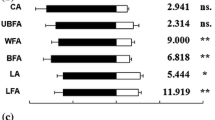Abstract
In the field, adult psyllids,Heteropsylla cubana Crawford, oriented significantly more towards the caged seedlings of susceptibleLeucaena leucocephala (Lam.) de Wit than to those of the resistant tree species,Leucaena collinsii Britton & Rose, or the nonhostAmaranthus spinosus L. In a dual-choice bioassay using a still-air olfactometer, the females demonstrated a strong positive response to the hexane extract ofL. leucocephala leaves at 1×10−3 g equivalents (g eq) of leaf material. The females did not orient to leaf extracts ofL. collinsii at high concentrations but responded positively at a lower concentration of 1×10−4 g eq. Olfactory discrimination byH. cubana between resistant and susceptible host species should be considered in selection and breeding programs.
Similar content being viewed by others
References
Beck, S.D., andSchoonhoven, L.M. 1980. Insect behavior and insect resistance, pp. 115–135,in F.G. Maxwell and P.R. Jennings (eds.). Breeding Plants Resistant to Insects. Wiley, New York.
Blust, M.H., andHopkins, T.L. 1987. Olfactory responses of a specialist and a generalist grasshopper to volatiles ofArtemisia ludoviciana Nutt. (Asteraceae).J. Chem. Ecol. 13:1893–1902.
Dethier, V.G. 1980. Evolution of receptor sensitivity to secondary plant substances with special reference to deterrents.Am. Nat. 115:45–66.
Dethier, V.G. 1982. Mechanisms of host plant recognition.Entomol. Exp. Appl. 31:49–56.
Dickens, J.C. 1984. Olfaction in the boll weevil,Anthonomus grandis Boh. (Coleoptera: Curculionidae): Electroantennogram studies.J. Chem. Ecol. 10:1759–1785.
Eijackers, H.J.P., andvan Lenteren, J.C. 1970. Host choice and host discrimination inPseudeucoila bochei.Neth. J. Zool. 20:414.
Gomez, K.A., andGomez, A.A. 1984. Statistical Procedures for Agricultural Research. Wiley, New York.
Lapis, E.B. 1991. A comparative study on the susceptibility of two species ofLeucaena toHeteropsylla cubana Crawford (Homoptera; Psyllidae). PhD thesis. Simon Fraser University, Burnaby, British Columbia, Canada.
Lapis, E.B., andBorden, J.H. 1993. Components of resistance inLeucaena collinsii (Leguminosae) to the psyllid,Heteropsylla cubana (Homoptera: Psyllidae).Environ. Entomol. (in press).
McFadden, M.W. 1986. Evaluation ofLeucaena/Heteropsylla problem in Hawaii, the Philippines and New Caledonia. Forestry Support Program, USDA Forest Service, Washington, D.C.
Prokopy, R.J., andOwens, E.D. 1983. Visual detection of plants by herbivorous insects.Annu. Rev. Entomol. 28:337–364.
Rodriguez, J.G., Kemp, T.R., andDabrowski, Z.T. 1976. Behavior ofTetranychus urticae toward essential oil mixtures from strawberry foliage.J. Chem. Ecol. 2:221–230.
Smith, R.F. 1989. Exploitation of seasonal development and semiochemicals for refinement of pest manageement programs involving the Müllein bug,Campylomma verbasci (Meyer) and pear psylla,Psylla pyricola Foerster. PhD thesis. Simon Fraser University, Burnaby, British Columbia, Canada.
Tingle, F.C., Mitchell, E.R., andHeath, R.R. 1990. Preference of matedHeliothis viriscens andH. subflexa females for host and nonhost volatiles in a flight tunnel.J. Chem. Ecol. 16:2889–2898.
Vincent, C., andStewart, R.K. 1984. Effect of allyl isothiocyanate on field behavior of crucifer feeding flea beetles (Coleoptera: Chrysomelidae).J. Chem. Ecol. 10:33–39.
Visser, J.H., andAvé, D.A. 1978. General green leaf volatiles in the olfactory orientation of the Colorado potato beetle,Leptinotarsa decemlineata.Entomol. Exp. Appl. 24:538–549.
Whitman, D.W., andEller, F.J. 1987. Parasitic wasps orient to green leaf volatiles.Chemoecology 1:69–75.
Yamamoto, R.T., Jenkins, R.Y., andMcClusky, R.K. 1969. Factors determining the selection of plants for oviposition by the tobacco hornwormManduca sexta.Entomol. Exp. Appl. 12:504–508.
Zar, J.H. 1984. Biostatistical Analysis. Prentice-Hall, Englewood Cliffs, New Jersey.
Author information
Authors and Affiliations
Rights and permissions
About this article
Cite this article
Lapis, E.B., Borden, J.H. Olfactory discrimination byHeteropsylla cubana (Homoptera: Psyllidae) between susceptible and resistant species ofLeucaena (Leguminosae). J Chem Ecol 19, 83–90 (1993). https://doi.org/10.1007/BF00987473
Received:
Accepted:
Issue Date:
DOI: https://doi.org/10.1007/BF00987473




